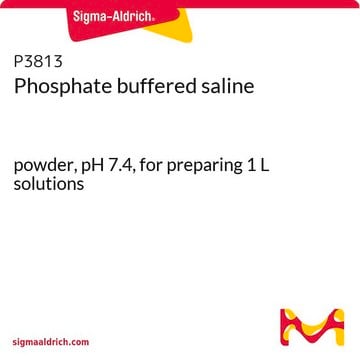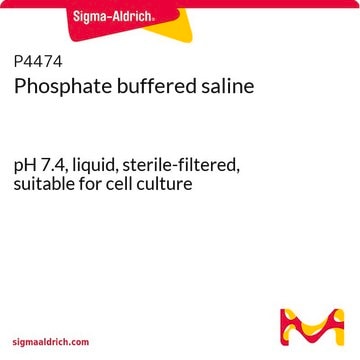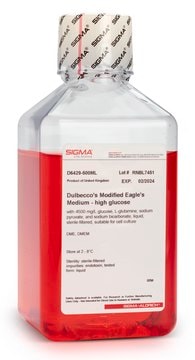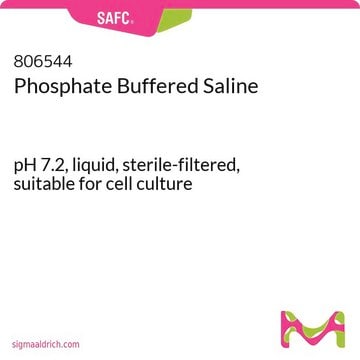This item is a multi-component product. A CAS number cannot be applied to this type of product. The Safety Data Sheet document includes the individual CAS numbers of those components that may be potentially hazardous.
D8537
Dulbecco′s Phosphate Buffered Saline
liquid, Modified, without calcium chloride and magnesium chloride, liquid, sterile-filtered, suitable for cell culture
Synonym(s):
DPBS
About This Item
Recommended Products
Product Name
Dulbecco′s Phosphate Buffered Saline, Modified, without calcium chloride and magnesium chloride, liquid, sterile-filtered, suitable for cell culture
Quality Level
sterility
sterile-filtered
form
liquid
technique(s)
cell culture | mammalian: suitable
impurities
endotoxin, tested
components
glucose: no (Dextro)
sodium pyruvate: no
shipped in
ambient
Looking for similar products? Visit Product Comparison Guide
General description
Application
also commonly purchased with this product
Storage Class Code
12 - Non Combustible Liquids
WGK
WGK 1
Flash Point(F)
Not applicable
Flash Point(C)
Not applicable
Choose from one of the most recent versions:
Certificates of Analysis (COA)
Don't see the Right Version?
If you require a particular version, you can look up a specific certificate by the Lot or Batch number.
Already Own This Product?
Find documentation for the products that you have recently purchased in the Document Library.
Customers Also Viewed
Protocols
Cell culture protocol for passaging and splitting adherent cell lines using trypsin EDTA. Free ECACC handbook download.
Cell culture protocol for passaging and splitting adherent cell lines using trypsin EDTA. Free ECACC handbook download.
Cell culture protocol for passaging and splitting adherent cell lines using trypsin EDTA. Free ECACC handbook download.
Cell culture protocol for passaging and splitting adherent cell lines using trypsin EDTA. Free ECACC handbook download.
-
Bonjour, pourriez-vous m'indiquer le numéro de CAS de la solution de phosphate saline dulbecco sous forme liquide
1 answer-
Helpful?
-
-
Hi, is this product GMP-grade or are GMP-garde material is used for the production of this?
1 answer-
This product is not GMP-grade. Unfortunately. a GMP-grade version of this product is not available.
Helpful?
-
-
What is the concentration of the product in Molarity?
1 answer-
This is a multi-component formulation. A 'molarity' is not reported for this type of product. See below for the list of components:
Product D8537 contains:
Potassium chloride: 0.2 g/l
Potassium phosphate monobasic: 0.2 g/l
Sodium chloride: 8 g/l
Sodium Phosphate dibasic: 1.15 g/lPlease see the link below for additional information:
https://www.sigmaaldrich.com/deepweb/assets/sigmaaldrich/product/documents/124/464/d8537for.pdfHelpful?
-
-
What is the bottle thread type on the 1L bottle (D8537-1L)
1 answer-
The product is packaged in a square PET bottle with an HDPE cap. The cap specifications are as follows:
Thread Type 38-430
Thread Diameter 37.3 mmHelpful?
-
-
What is the Department of Transportation shipping information for this product?
1 answer-
Transportation information can be found in Section 14 of the product's (M)SDS.To access the shipping information for this material, use the link on the product detail page for the product.
Helpful?
-
-
Is Product D8537, Dulbecco's Phosphate, a 1X or 10 X concentration?
1 answer-
This is a 1X concentration. The 10X concentration is listed under product D1408.
Helpful?
-
-
What is a Salt Toxicity Test?
1 answer-
The Cell Culture assay is called a Salt Toxicity Test (previously called Cell Culture Salt Testing). A more complete description is below:Cells are harvested and counted. They are resuspended in DPBS and incubated at 37°C, 5% CO2 for 1 hour. The cells are counted and %viability determined. The cells are then cultured for an additional 7 hours (total of 8 hours). The cells are counted again and the % viability determined. The viability at 1 hr has to be >95% of the original viability. The viability at 8 hrs must be >75% of the original viability.
Helpful?
-
-
What is the formulation for Product D8537, Dulbecco's Phosphate?
1 answer-
The formulation for 1 liter is 8 g Sodium Chloride, 0.2 g Potassium Phosphate, monobasic, 1.15 g Sodium Phosphate, dibasic, and 0.2 g Potassium Chloride.
Helpful?
-
-
What is the pH of a solution of Product D8537, Dulbecco's Phosphate?
1 answer-
The pH will be in the range of 7.1-7.5, according to the specification sheet.
Helpful?
-
Active Filters
Our team of scientists has experience in all areas of research including Life Science, Material Science, Chemical Synthesis, Chromatography, Analytical and many others.
Contact Technical Service











